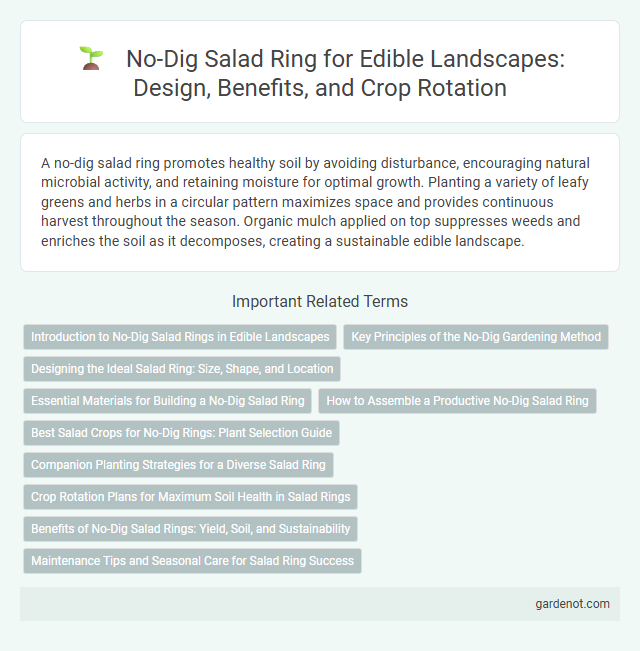A no-dig salad ring promotes healthy soil by avoiding disturbance, encouraging natural microbial activity, and retaining moisture for optimal growth. Planting a variety of leafy greens and herbs in a circular pattern maximizes space and provides continuous harvest throughout the season. Organic mulch applied on top suppresses weeds and enriches the soil as it decomposes, creating a sustainable edible landscape.
Introduction to No-Dig Salad Rings in Edible Landscapes
No-dig salad rings revolutionize edible landscapes by eliminating soil disturbance, promoting healthy microbe activity, and enhancing soil structure. This sustainable gardening method layers organic materials like compost, mulch, and kitchen scraps to create nutrient-rich soil that supports vibrant salad greens. Ideal for small spaces, no-dig salad rings maximize productivity and reduce labor while fostering biodiversity and soil health.
Key Principles of the No-Dig Gardening Method
The No-Dig Gardening Method prioritizes soil health by maintaining undisturbed soil layers, encouraging natural microbial activity essential for nutrient cycling in edible landscapes. Creating a No-Dig Salad Ring involves layering organic mulches like compost and straw without tilling, preserving soil structure and moisture retention while suppressing weeds. This approach supports biodiversity, enhances soil fertility, and promotes sustainable, low-maintenance salad production directly within garden beds.
Designing the Ideal Salad Ring: Size, Shape, and Location
Designing the ideal no-dig salad ring requires careful consideration of size, shape, and location to maximize yield and ease of harvest. A circular or oval shape with a diameter of 4 to 6 feet allows efficient planting and harvesting while promoting healthy growth of mixed salad greens like lettuce, arugula, and spinach. Positioning the salad ring in a sunny location with well-drained soil and easy access ensures optimal sunlight exposure and reduces maintenance efforts in edible landscape design.
Essential Materials for Building a No-Dig Salad Ring
Essential materials for building a no-dig salad ring include layers of organic mulch, compost, and cardboard or newspaper to suppress weeds and retain moisture. Incorporating nutrient-rich soil amendments such as well-aged compost and vermicompost creates an ideal growing environment for diverse salad greens. Using natural borders like stones or logs helps define the circular shape while contributing to soil health and biodiversity within the edible landscape.
How to Assemble a Productive No-Dig Salad Ring
Create a No-Dig Salad Ring by arranging nutrient-rich compost in a circular bed, layering organic mulch to retain moisture and suppress weeds. Select a diverse mix of salad greens like arugula, spinach, and lettuce for continuous harvest and maximize space efficiency. Water consistently and avoid disturbing the soil, promoting healthy root development and robust plant growth.
Best Salad Crops for No-Dig Rings: Plant Selection Guide
Best salad crops for no-dig salad rings include fast-growing, shallow-rooted leafy greens like arugula, spinach, and various lettuces, which thrive without soil disturbance. Herbs such as basil, chives, and cilantro also perform well, enhancing flavor variety and garden biodiversity. Selecting crops known for their adaptability to compact layers and minimal soil interference ensures productive, low-maintenance harvests in edible landscapes.
Companion Planting Strategies for a Diverse Salad Ring
A no-dig salad ring thrives through companion planting strategies that enhance soil health, pest control, and nutrient sharing among diverse salad greens and herbs. Integrating plants like lettuce, spinach, radishes, and chives in concentric circles maximizes space while promoting mutual growth benefits and natural pest deterrence. This biodiversity reduces the need for fertilizers and pesticides, supporting sustainable edible landscaping with rich, flavorful harvests.
Crop Rotation Plans for Maximum Soil Health in Salad Rings
No-dig salad rings benefit from strategic crop rotation plans that enhance soil health by minimizing nutrient depletion and disrupting pest cycles. Incorporating diverse plant families such as leafy greens, root vegetables, and legumes in successive planting cycles boosts organic matter and promotes beneficial microbial activity. This sustainable practice maintains soil structure and fertility, ensuring maximum productivity and resilience in edible landscapes.
Benefits of No-Dig Salad Rings: Yield, Soil, and Sustainability
No-dig salad rings significantly increase yield by creating optimal growing conditions through minimal soil disturbance, promoting healthy root systems and enhanced nutrient uptake. This method improves soil structure and fertility by maintaining microbial activity and organic matter, reducing erosion and compaction. Sustainable gardening benefits include reduced labor, lower carbon footprint, and minimized weed growth, making no-dig salad rings an eco-friendly solution for productive edible landscapes.
Maintenance Tips and Seasonal Care for Salad Ring Success
Maintaining a no-dig salad ring involves regular watering to keep the soil consistently moist without overwatering, which helps prevent root rot. Seasonal care includes mulching in colder months to protect plants from frost and removing any dead leaves to encourage healthy growth in spring. Crop rotation and adding organic compost annually enhance soil fertility, ensuring a thriving edible landscape year-round.
No-dig salad ring Infographic

 gardenot.com
gardenot.com